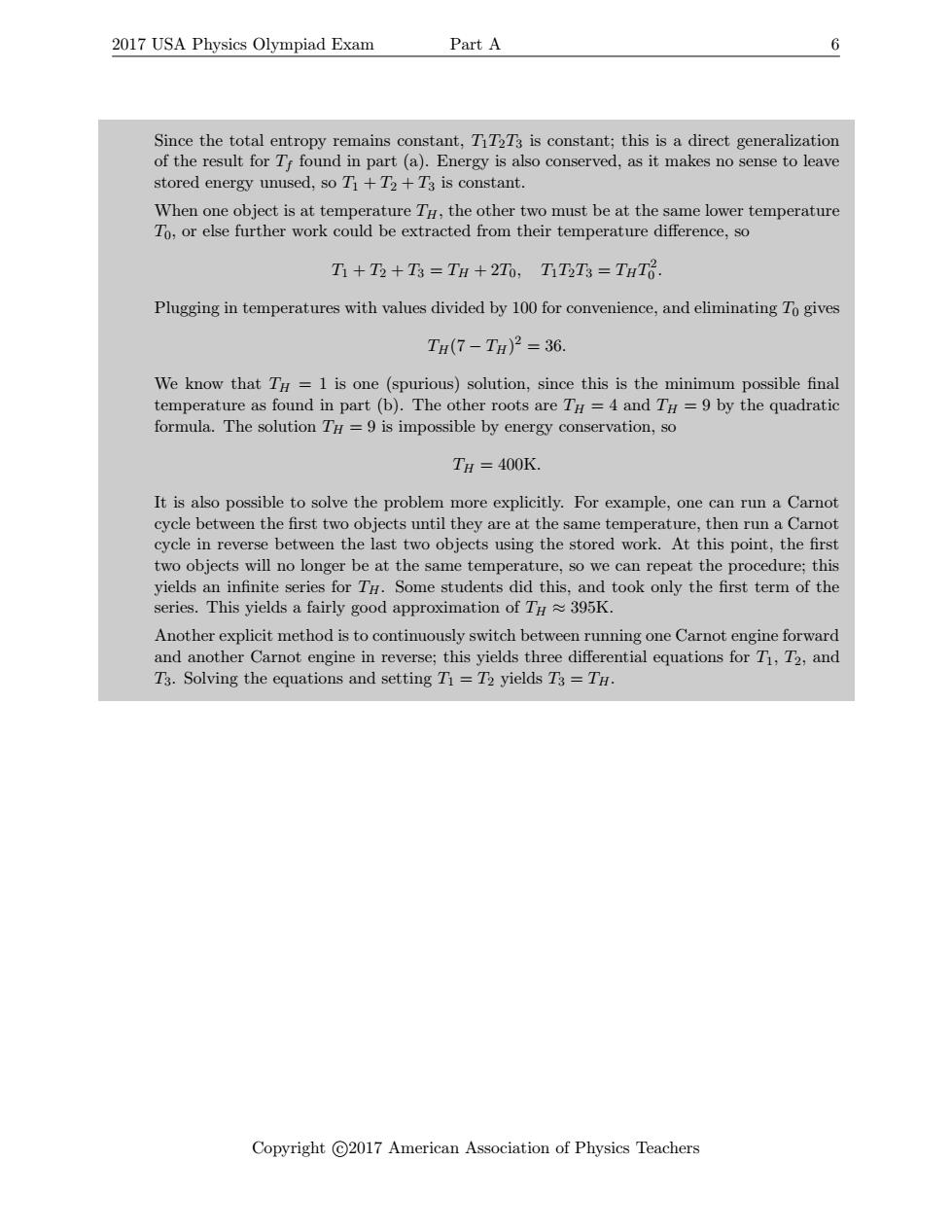正在加载图片...

2017 USA Physics Olympiad Exam Part A 6 Since the total entropy remains constant,TiT2T3 is constant;this is a direct generalization of the result for Tf found in part (a).Energy is also conserved,as it makes no sense to leave stored energy unused,so Ti+T2+T3 is constant. When one object is at temperature TH,the other two must be at the same lower temperature To,or else further work could be extracted from their temperature difference,so T+T2+T3 TH +2To,TT2T3 THTo. Plugging in temperatures with values divided by 100 for convenience,and eliminating To gives TH(7-TH)2=36 We know that TH 1 is one (spurious)solution,since this is the minimum possible final temperature as found in part (b).The other roots are Ty=4 and TH =9 by the quadratic formula.The solution TH=9 is impossible by energy conservation,so TH=400K. It is also possible to solve the problem more explicitly.For example,one can run a Carnot cycle between the first two objects until they are at the same temperature,then run a Carnot cycle in reverse between the last two objects using the stored work.At this point,the first two objects will no longer be at the same temperature,so we can repeat the procedure;this yields an infinite series for TH.Some students did this,and took only the first term of the series.This yields a fairly good approximation of TH395K. Another explicit method is to continuously switch between running one Carnot engine forward and another Carnot engine in reverse;this yields three differential equations for T1,T2,and T3.Solving the equations and setting T1=T2 yields T3=TH. Copyright C2017 American Association of Physics Teachers2017 USA Physics Olympiad Exam Part A 6 Since the total entropy remains constant, T1T2T3 is constant; this is a direct generalization of the result for Tf found in part (a). Energy is also conserved, as it makes no sense to leave stored energy unused, so T1 + T2 + T3 is constant. When one object is at temperature TH, the other two must be at the same lower temperature T0, or else further work could be extracted from their temperature difference, so T1 + T2 + T3 = TH + 2T0, T1T2T3 = THT 2 0 . Plugging in temperatures with values divided by 100 for convenience, and eliminating T0 gives TH(7 − TH) 2 = 36. We know that TH = 1 is one (spurious) solution, since this is the minimum possible final temperature as found in part (b). The other roots are TH = 4 and TH = 9 by the quadratic formula. The solution TH = 9 is impossible by energy conservation, so TH = 400K. It is also possible to solve the problem more explicitly. For example, one can run a Carnot cycle between the first two objects until they are at the same temperature, then run a Carnot cycle in reverse between the last two objects using the stored work. At this point, the first two objects will no longer be at the same temperature, so we can repeat the procedure; this yields an infinite series for TH. Some students did this, and took only the first term of the series. This yields a fairly good approximation of TH ≈ 395K. Another explicit method is to continuously switch between running one Carnot engine forward and another Carnot engine in reverse; this yields three differential equations for T1, T2, and T3. Solving the equations and setting T1 = T2 yields T3 = TH. Copyright c 2017 American Association of Physics Teachers